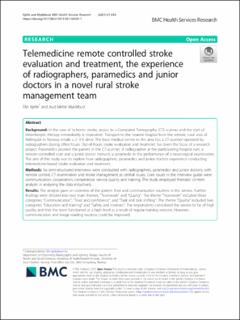| dc.contributor.author | Kjelle, Elin | |
| dc.contributor.author | Myklebust, Aud Mette | |
| dc.date.accessioned | 2022-03-17T12:55:57Z | |
| dc.date.available | 2022-03-17T12:55:57Z | |
| dc.date.created | 2021-06-08T11:03:23Z | |
| dc.date.issued | 2021 | |
| dc.identifier.citation | Kjelle, E. & Myklebust, A. M. (2021). Telemedicine remote controlled stroke evaluation and treatment, the experience of radiographers, paramedics and junior doctors in a novel rural stroke management team. BMC Health Services Research, 21, Artikkel 554. | en_US |
| dc.identifier.issn | 1472-6963 | |
| dc.identifier.uri | https://hdl.handle.net/11250/2985867 | |
| dc.description.abstract | Background: In the case of ischemic stroke, access to a Computed Tomography (CT) scanner and the start of thrombolytic therapy immediately is imperative. Transport to the nearest hospital from the remote, rural area of Hallingdal in Norway entails a 2–3 h drive. The local medical centre in this area has a CT-scanner operated by radiographers during office hours. Out-of-hours stroke evaluation and treatment has been the focus of a research project. Paramedics position the patient in the CT-scanner. A radiographer at the participating hospital runs a remote-controlled scan and a junior doctor instructs a paramedic in the performance of a neurological examination. The aim of this study was to explore how radiographers, paramedics and junior doctors experience conducting telemedicine-based stroke evaluation and treatment.
Methods: Six semi-structured interviews were conducted with radiographers, paramedics and junior doctors; with remote control, CT examination and stroke management as central issues. Core issues in the interview guide were: communication; cooperation; competence; service quality and training. The study employed thematic content analysis in analysing the data inductively.
Results: The analysis gave an overview of the patient flow and communication routines in this service. Further findings were divided into two main themes, “Teamwork” and “Quality”. The theme “Teamwork” included three categories “Communication”, “Trust and confidence”, and “Task and task shifting”. The theme “Quality” included two categories “Education and training” and “Safety and routines”. The respondents considered the service to be of high quality and that the team functioned at a high level as a result of regular training sessions. However, communication and image reading routines could be improved.
Conclusions: The telemedicine-based, remote controlled, stroke evaluation and treatment was experienced, by the participants, to be well organised and of high quality. Communication and image reading appear to be the salient challenges. Regular training sessions and follow-up, as well as an evaluation of incidents by the project manager, proved to be of great importance in retaining and securing the continued running of the service and ensuring high-quality treatment. Further research is indicated in the comparison of this telemedicine service with stroke treatment given in a mainstream hospital. | en_US |
| dc.language.iso | eng | en_US |
| dc.rights | Navngivelse 4.0 Internasjonal | * |
| dc.rights.uri | http://creativecommons.org/licenses/by/4.0/deed.no | * |
| dc.title | Telemedicine remote controlled stroke evaluation and treatment, the experience of radiographers, paramedics and junior doctors in a novel rural stroke management team | en_US |
| dc.type | Peer reviewed | en_US |
| dc.type | Journal article | en_US |
| dc.description.version | publishedVersion | en_US |
| dc.rights.holder | © The Author(s). 2021. | en_US |
| dc.source.volume | 21 | en_US |
| dc.source.journal | BMC Health Services Research | en_US |
| dc.identifier.doi | https://doi.org/10.1186/s12913-021-06591-1 | |
| dc.identifier.cristin | 1914429 | |
| dc.source.articlenumber | 554 | en_US |
| cristin.ispublished | true | |
| cristin.fulltext | original | |
| cristin.qualitycode | 2 | |

